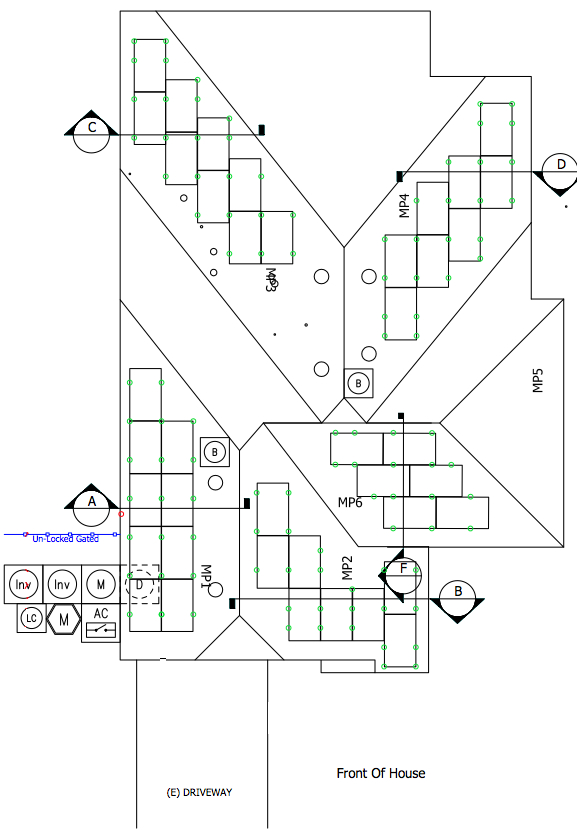Well, after another site survey, we received our final system design from SolarCity. Thankfully, they were able to use the roof areas I asked about and the output of the system has gone from 18,061 kWh per year (12.5 kW DC system) to 9,673 kWh per year (8 kW DC system) to, finally, to 12,151 kWh per year (10 kW DC system). It’s still well below what we were wanting, but that’s dictated by roof orientation more than anything else. I am glad they were able to utilize the roof areas and boost system output by 26% (and went from 32 panels to 40). Oddly enough, the rebates available for my system, from the electric utility, is a 10 kW DC system, the same size as the final proposed system…
 Originally, SolarCity said they needed a clear area of three feet square for the inverter in the garage. I think this new design calls for the inverter being on an exterior wall but the original clearance area may have just been needed during installation, as the unit is fairly thin. The next step is to apply for Home Owner’s Association approval.
Originally, SolarCity said they needed a clear area of three feet square for the inverter in the garage. I think this new design calls for the inverter being on an exterior wall but the original clearance area may have just been needed during installation, as the unit is fairly thin. The next step is to apply for Home Owner’s Association approval.
All through the planning of the solar panel array, I have been expecting the two Chevrolet Volts to use 12.8 kWh per charge. If we fully charged the batteries every day, that would require 9,344 kWh per year. This latest design (if it performs as anticipated) would give us an additional 234 kWh per month to displace grid-provided electricity for the house. We are anticipating non-EV electrical usage at 727 kWh per month, so the amount of electric usage, above and beyond EV usage, would have about one-third provided by the solar panels.
Now that I work at a company that has free level 2 chargers available to me, my Volt only gets about 1/2 of its charge each work day at home. That would reduce the Volts’ usage of electricity (at our home) from 9,344 kWh per year to around 7,655 kWh per year, adding another 140 kWh per month we can use to offset electricity used by the house. That total of 374 kWh per month should displace 52% of the electricity we would get from current our electricity provider (pun intended).
Just like I did with the Volts, now’s the time to estimate the financial impact of the solar array. Here are the assumptions:
- Chevy Volts will use 7,655 kWh per year (638 kWh per month) at our home.
- The house will use 8,724 kWh per year (727 kWh per month).
- The array will provide 12,151 kWh of clean electricity per year.
- Our down payment for the array is $1,292.82
- Our electricity cost, from our electric provider, is 10.725 cents per kWh.
- Our electricity cost, from the solar panels, is 6.89 cents per kWh (and is locked at that rate for 20 years)
- Our electric utility will buy back the first 500 kWh of surplus at retail pricing and all energy above the first 500 kWh of surplus at wholesale pricing, although this is not guaranteed over the 20 year contract with Solar City.
This “buy back” is the scariest part of all this. As I’ve mentioned before, as more people adopt solar energy for their homes, it is only natural that the energy companies see those people as a threat to their business. Eventually, I expect almost every electric utility to try to overthrow net metering. For people like us, that have signed up for 20 years of electric service from SolarCity, or for those who just paid for their systems outright, the revocation of net metering would throw a MAJOR wrench into our carefully calculated plans. It’s a gamble we’re going to take, obviously.
So, if net metering stays in effect, here’s what we expect:
- House and EV cost of electricity per month (no solar panel system): $146.40
- Cost of down payment for solar system, as a monthly cost: $5.39
- Cost of electricity provided monthly by SolarCity: $69.77
- Cost of electricity provided monthly by Green Mountain Energy: $37.79
- Total monthly electricity cost:
- If purchased from electric utility: $146.40
- if purchased from combination of solar panels and electric utility: $112.95
- monthly savings: $33.45, or about 23% of our bill.
- If we break out the down payment and consider it a prepayment for electricity, we would break even on the down payment in the 33rd month of the agreement. Since we usually stay in a house ten years, we will easily recoup the downpayment through our savings on electricity.
That doesn’t seem like much of a savings, but that includes all costs, installation, system monitoring, insurance for system, and repairs, over the entire 20 year term of the agreement. Also, it does not take into account the future cost of electricity from a traditional electric provider. If electric rates went up only 1% per year, the price per kWh would rise to 12.957 cents per kWh and the monthly difference in the final year of the contract would be $45.82. SolarCity’s proposals usually quote an expected rise of 2.5% per year, although I’m not sure that’s realistic. If that did come to pass, the rate in year 20 would be 17.146 cents per kWh and the monthly savings would be $61.85!
Now here’s a few variables that keep me awake at night:
- If the EVs are charged after sundown, how is the monthly electricity surplus calculated for net metering? In other words, are we paying the utility rate for the electricity going into the cars, because the panels aren’t producing when we’re charging? This looms important, because the amount of electricity used by car charging is more than the monthly surplus paid for at retail pricing.
- What if electric rates go down in the future? (they’re fixed with SolarCity for 20 years)
- What happens when (not if) electric utilities stop paying for excess electricity generated?
- How does changing electricity demand by season affect the amount of surplus generated?
- Will my Home Owner’s Association put up a fight or accept our proposal?
As usual, stay tuned to these answers and more tales of going green!


Buzz:
Thanks for sharing! I have a Volt and I am looking at an i3 to add to the stable.
I am in the process of kicking off a project to install a 9 kW system. I am located in the Southwest Suburbs of Chicago.
I haven’t gone to the extent you have to calculate all that, above, interesting stuff!
I am doing our system as an outright purchase. With Federal and State incentives, we only have to pay about 35-40% of the cost of the system from our own pocket.
Good luck with your project! I look forward to hearing about how it turns out.
-Pete D